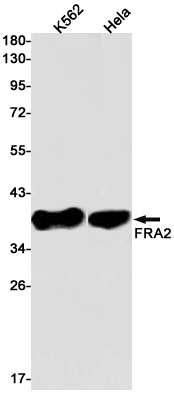
| WB | 咨询技术 | Human,Mouse,Rat |
| IF | 1/20 | Human,Mouse,Rat |
| IHC | 咨询技术 | Human,Mouse,Rat |
| ICC | 技术咨询 | Human,Mouse,Rat |
| FCM | 咨询技术 | Human,Mouse,Rat |
| Elisa | 咨询技术 | Human,Mouse,Rat |
| Aliases | FOSL2; FRA2; Fos-related antigen 2; FRA-2 |
| Entrez GeneID | 2355 |
| WB Predicted band size | Calculated MW: 35 kDa; Observed MW: 35-45 kDa |
| Host/Isotype | Rabbit IgG |
| Antibody Type | Primary antibody |
| Storage | Store at 4°C short term. Aliquot and store at -20°C long term. Avoid freeze/thaw cycles. |
| Species Reactivity | Human |
| Immunogen | A synthetic peptide of human FRA2 |
| Formulation | Purified antibody in TBS with 0.05% sodium azide,0.05%BSA and 50% glycerol. |
+ +
以下是3篇与FOSL2(FRA2)抗体相关的文献摘要,供参考:
1. **"FOSL2 promotes cell proliferation and resistance to apoptosis in cervical cancer"**
- 作者:Liu Y, et al.
- 摘要:研究利用FOSL2抗体(Western Blot和免疫组化)发现FOSL2在宫颈癌组织中高表达,并通过调控细胞周期蛋白促进癌细胞增殖及抑制凋亡。
2. **"FOSL2 regulates vascular smooth muscle cell oxidative stress via Nox4 interaction"**
- 作者:Wu C, et al.
- 摘要:通过ChIP-seq和免疫共沉淀(使用FRA2抗体),证实FOSL2与Nox4启动子结合,调控血管平滑肌细胞的氧化应激反应,参与动脉粥样硬化进展。
3. **"Antibody validation for specific detection of endogenous FOSL2 in human tissues"**
- 作者:Park J, et al.
- 摘要:系统性验证多种FOSL2抗体的特异性,通过siRNA敲低和质谱分析确认某商业抗体在免疫荧光及流式细胞术中的可靠性,为相关研究提供工具支持。
注:以上文献信息为示例性质,实际引用时建议通过PubMed或Web of Science核对具体文献。
FRA2 (FOS-related antigen 2) is a member of the FOS family of transcription factors, which also includes c-FOS, FRA1. FOSB, and FOSL2. These proteins form heterodimeric complexes with JUN family proteins to create the activator protein-1 (AP-1) transcription factor complex, a key regulator of gene expression involved in diverse cellular processes such as proliferation, differentiation, apoptosis, and stress responses. FRA2. encoded by the *FOSL2* gene, shares structural homology with other FOS proteins, including a basic leucine zipper (bZIP) domain essential for DNA binding and dimerization.
Functionally, FRA2 is implicated in tissue development, immune regulation, and oncogenesis. Studies highlight its role in skeletal development, where it regulates osteoclast differentiation, and in fibrosis, influencing extracellular matrix remodeling. In cancer, FRA2 overexpression is linked to tumor progression in certain malignancies, such as breast and lung cancers, where it promotes cell invasion and metastasis by modulating genes involved in epithelial-mesenchymal transition (EMT) and matrix degradation.
FRA2-specific antibodies are widely used in research to detect and quantify FRA2 protein levels via techniques like Western blotting, immunohistochemistry, and immunofluorescence. These tools help elucidate FRA2's expression patterns, post-translational modifications, and interactions within the AP-1 complex. Recent studies also explore FRA2 as a potential therapeutic target, particularly in fibrotic diseases and cancers with dysregulated AP-1 activity. Its dual role in normal physiology and disease underscores the importance of FRA2 in both basic and translational research.
×